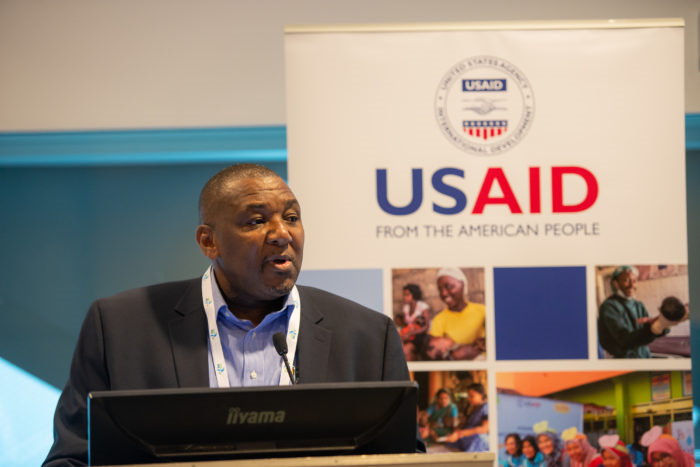Related Project: Coordinating Implementation Research to Communicate Learning and Evidence (CIRCLE)
Author(s): Elizabeth Macgregor-Skinner, Project Director, CIRCLE Project
USAID’s Health Research Program hosted a stimulating session on the role of implementation research in accelerating uptake of essential services and approaches to improve maternal, newborn and child health. USAID’s Barbara Hughes cited implementation research as an approach that is helping programs become more efficient at reducing maternal mortality.
Keynote speaker Dr. Koku Awoonor-Williams, the policy director of Ghana Health Service, described how the country used implementation research as part of real-time learning to guide operations for its community health program. By studying the effects of community health workers and adjusting the program as needed, Ghana accelerated and scaled up its community health program from three communities in 1994 to more than 5000 communities today. During this time, maternal mortality declined 49% in the regions that implemented this program.
The first session featured two case studies that described the process of implementation research for prevention of newborn sepsis in Nepal, and respectful maternity care in Kenya, both of which generated strong interest. Audience members were keen to hear about the sometimes challenging path from evidence generation to policy change. For both, program managers and researchers approached problems by generating evidence and then adapting the interventions for the local context.
For over ten years, USAID has worked to introduce and scale the use of chlorhexidine for umbilical cord care around the world. Starting with the investment in Nepal, this effort has resulted in 28 countries introducing chlorhexidine as part of their newborn health programs.Leela Khanal of JSI in Nepal, explained the pathway that Nepal took to engage policy makers to change guidelines, and manufacturers to produce appropriate chlorhexidine products for the market. Since that time, Nepal’s efforts have saved more than 12,000 newborn lives.

Photo credit: Ant Clausen
“In the case of chlorhexidine introduction in Nepal, “The difference between an implementation research approach in Nepal as opposed to traditional research is that researchers shared knowledge immediately and did not wait for their paper to be published.”
– Steve Hodgins (University of Alberta)
Timothy Abuya from Population Council spoke on the evolution of respectful maternity care in Kenya. Under the USAID-funded TRAction project, the research team deliberately engaged policy makers, implementers and other stakeholders to understand why this issue had such a critical impact on maternal mortality in the country. They had to balance the need to act with the time to engage and bring stakeholders on board to the process, in order to achieve a longer-term effect. Commentator Blerta Maliki of the World Health Organization stressed that despite all that we know of best practices and approaches, the challenge is to contextualize our best practices in maternal and child health programs and transfer learnings to other settings.

“We just joined a collaboration to submit a proposal about implementation research in maternal and child health for rural and indigenous communities in Panama…It is new for me and for us in Panama. My main takeaway message from today is that I must work closely with policy makers from the beginning. The research has to be responsive to the needs of policy makers for them to then adopt the results.”
— Luz Romero, Secretaría Nacional de Ciencia, Tecnología e Innovación, Panamá
The final session, moderated by Lisa Hirschhorn from the University of Michigan, brought a mix of researchers, donors, implementers and policy makers together in an open and sometimes provocative discussion. Panelists shared their experiences as users, conductors or consumers of research, and also of the partnerships that are critical to successful implementation research. My take-home messages from this include:
- Lola Adedokun (Doris Duke Charitable Foundation): funders and policymakers should be open to the valuable lessons offered by failure – it’s a chance to refine the intervention for greater impact.
- Stefan Peterson (UNICEF): be open to changing the concept of what is implementation research. “…fix the airplane while we are flying it… rather than waiting for the endline evaluation.”
- Beati Mboya (CIRCLE Project): Capacity building for embedded research should include building the capacity of policy makers, donors, and partners (not just researchers).
The session ended with a renewed commitment by a broad coalition to support implementation research going forward. As announced by Neal Brandes of USAID: “The coalition hopes to address the challenges of equitable implementation, sustainable programs and scale up through wider use of implementation research and delivery science embedded in real-time policy making, program management, and health service practice.” Coalition members include USAID, UNICEF, WHO Alliance, the Doris Duke Charitable Foundation, and the World Bank, but other interested groups were encouraged to join.

This blog was cross-posted from the USAID website.
